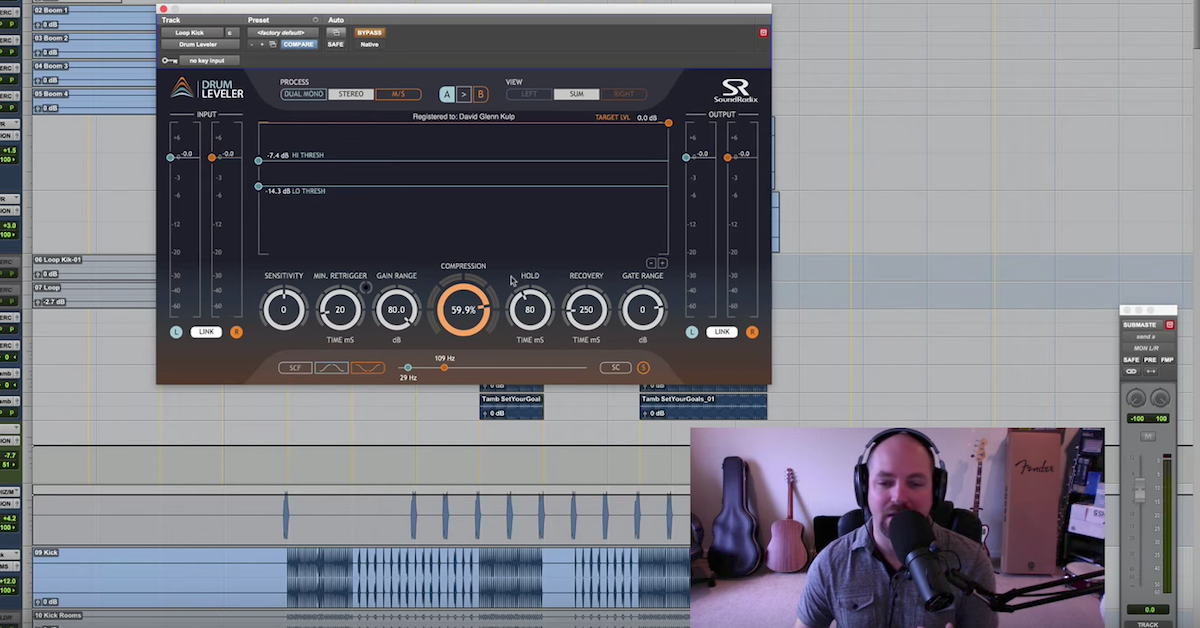50 Steps to Transform a Simple MIDI Drum Loop Into a Complete Track
Article Content
The following are some ideas for transforming a simple MIDI drum loop into a complex multitrack MIDI session.
Many of the techniques focus on the combined use of randomization (pitch, velocity, duration), scale quantization, subtractive composition, and embracing the serendipitous.
For instance, you may end up with polyphonic events on a monophonic instrument track but simply like the “mistakes” and the way the instrument is forced to deal with them. Randomization followed by scale quantization and appropriate octave displacement can yield extremely fruitful results and content that you never would have conceived of any other way.
I used some of these methods to generate the demo synth track included with a video series I just completed for The Pro Audio Files called Synthesis 101. Have fun!
- Choose a 2 to 4 bar drum loop that has at least 3, preferably 4 or 5 samples being triggered (e.g. kick, snare, hi-hat, toms, shaker, etc.)
- Copy the loop to several empty MIDI/Instrument tracks
- On the first track place the soft synth or instrument of your choice and experiment with various sounds and presets. Thin out the number of events as appropriate.
- Try changing octaves of the MIDI notes based on what works best with the instrument
- Try randomizing all pitches, velocities and durations using the MIDI transform tool
- Once randomized, double the notes an octave above or below or both
- After randomizing, try quantizing the notes to a particular scale
- Try randomizing durations and/or velocities
- Adjust the instrument settings to make it more responsive to velocity variations.
- Separate the drum voices on subsequent tracks by deleting all but one voice from each region. This should leave you 3 to 5 tracks of single lines.
- Place a monophonic synth instrument on the kick track and find a thick bass sound.
- Delete every other note and change the pitch to match the harmony you have in mind
- Instead of deleting notes, try shifting the notes by a quarter or 8th note
- Try shifting notes by an octave, fifth or fourth interval
- On the snare line, load a polyphonic synth instrument with a percussive fast attack.
- Adjust the note to match the root, third or fifth of the harmony you have in mind and expand it upwards with diatonic transposition while keeping the lower notes in place. In other words, turn the single pitch into a chord. This could be done using a chord triggering MIDI plugin like the one found in Logic Pro.
- Try deleting every other chord or changing every other chord so it triggers a synth pad instead of the percussive sound.
- Take the HH track and randomly delete about 60% of the notes
- Load in a melodic instrument sound like a monophonic lead synth.
- Randomize the pitches within the key you’re using (or just randomly if it’s a more atonal approach)
- Experiment with glide controls, ADSR envelopes, vibrato, etc.
- Try recording some automation using the pitch bend wheel as the line plays
- Try recording some automation using the mod wheel as the line plays
- Try humanizing the rhythm of the melody line
- Try deleting every other bar of the melody
- After a few repeats, add a diatonic third or sixth above or below the melody on a different track with a different sound
- On the shaker track, delete 75% of the notes starting with the first note
- Load a high-pitched percussive monophonic synth sound to match the harmony
- On the Tom track, add a sampler instrument and load the sample of your choice
- Have the sample vary in pitch by 1 or 2 half steps on every event
- You should now have several tracks that are the length of the original drum loop, let’s say 4 bars.
- Duplicate the 4 bars and delete the original drum loop
- Duplicate the first 4 bars again and paste to the end (which would be bar 9)
- Delete all but one of the tracks and the drum loop track from bar 9 – 12
- In the drum loop track, delete all but the kick and HH from bar 9 – 12
- Duplicate the first 4 bars again and paste to the end (which would be bar 13)
- Delete all but the drum loop and two other tracks
- In the drum loop track, delete the shaker line
- Repeat steps 33 – 38 so that each time more events are present and less are deleted until you are back to the idea in bar 1 (this should take you up to bar 24 or so)
- Duplicate the entire session to double its length
- Transpose the harmony up a major 2nd, minor 3rd, perfect 4th or the interval of your choice (except for a minor 2nd because that’s simply too lame)
- Change one or more of the instrument settings
- After 8 bars, randomize all the harmony lines and then quantize to a completely different scale.
- Delete everything except the kick for 2 bars
- Add a synth pad based on the new harmony
- Add everything else back in
- Delete everything except the shaker for 1 bar
- Delete everything except the melody for 1 bar
- Return to beginning 8 bar idea in the most recent key
- Repeat while gradually (almost imperceptively) increasing speed
Return to zero and enjoy the ride!
Check out my other articles, reviews and interviews
Follow me on Twitter / Instagram / YouTube





